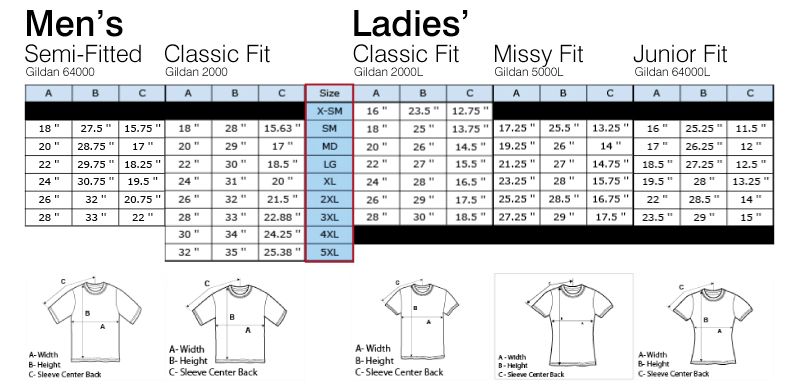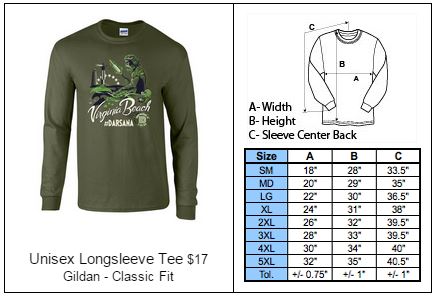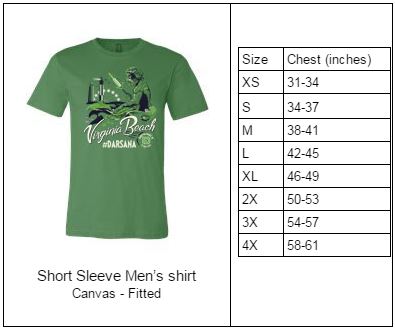Looking to buy yourself a t-shirt?
It used to be easy. There were a few major brands: Hanes, Fruit of the Loom, Gildan, and Anvil. Most t-shirts were all made to a standard size across brands. You could go into any shop, or order through the web or a catalog, and know how that shirt is going to fit you (unless you’ve put on a few pounds and are in denial – not talking about myself AT ALL).

Enter the world of fashion fitted tees. These are becoming kind of the standard for a lot of online shops that carry pop culture and indie tees: Threadless, Ript, TeeFury, Qwertee, etc. If you’re buying one of these for yourself for the first time, or buying one as a gift, you may not know what size to purchase.
This is even more difficult if you’re buying a woman’s shirt. What most people refer to as a “women’s” or “ladies” shirt is more appropriately called a juniors’ shirt. What’s the difference? Usually at least 2 sizes worth! Juniors’ sizes (think of it as a teen size instead) are very slim, often with an obviously pronounced waistline, and the length can vary from shorter to than average to much longer than average. Women’s shirts (sometimes called Missy sizes) will still be smaller than men’s shirts, but not as small as juniors. For instance I wear a 2XL in juniors, L in women’s/missy, and M or L in men’s (depending on manufacturer, style, material, and neckline!)
The trick is figuring out which cut it is because shops and manufacturers aren’t always on the same page. And, a busty woman can sometimes wear a size down if it’s a v-neck. The struggle is real!
This is very frustrating and it would be nice if manufacturers could agree on some standards.
Ok, what’s the difference between a fitted tee and a regular tee?
- It’s … well… fitted. A standard t-shirt is typically built in a very boxy, comfy shape. If you lay it out flat, you’ll see a straight line down from the shoulder to the bottom hem, and square-shaped sleeves. A fitted tee may be a bit more tapered at the waist and shoulder and an inch or two narrower and shorter. Women’s and Juniors will be even more tapered, sometimes with an obvious hourglass shape.
- Softer, thinner material. This is the one of the major benefits to these shirts – the cotton so soft and comfortable! The makes a cleaner design if you’re going to be decorating them, and will be more breathable in the summer. The downside? It drapes and clings a little more than a regular shirt, so this adds to the “fitted” look.
- Shorter length. Most men’s shirts will be a couple inches shorter than usual, so if you’re tall and don’t want to show off the top of your boxers, keep this in mind.
I decided to do a little experiment. Since Gildan has a wide range of styles in different types of material, I grabbed the specs from some of their most popular styles and lined them up to compare the differences. Gildan offers their size specs in actual shirt measurements (more on that below.) 
The difference is most visible between the classic and junior cut. There are 3 to 4.5 inches difference between the widths, which is equivalent to 6″ difference in chest size. Even the missy fit is a little smaller than the classic. Meanwhile, the lengths are pretty consistent across ladies styles. Compare this to the men’s shirts which vary little from the 2000 to 64000, and are similar in width to the ladies’ classic.
Let’s be real – for a lot of women, width & chest size on a shirt is the major issue and can make or break the fit. It can mean the difference between looking like a slob or looking well-dressed, and it can also be the difference between svelte and stuffed-in.
Tips on choosing the right size.
When you’re buying online, especially, choosing the right size can be a game of roulette. If you’re having trouble, here’s some things you can try.
- Always check the size chart. If a shop is nice enough to give you this info, follow their guidance! Be aware, there are a couple different ways to express this information: recommended body measurements of the wearer (3-dimensional; shown in the short sleeve image above) or shirt measurements (2-dimensional; long sleeve example).
Measure your best fitting t-shirt in the same way shown in the 2-D above, and compare the stats. If their size chart is 3-D, just measure the width of your shirt from armpit to armpit (measurement A above.) Double that and get your approximate chest size.
If it’s kind of close, size up (see tip #5) - Check other websites. There’s a great guideline on Teefury.com here where they actually show their shirts look in various sizes on different body types. Find the model that looks most like you (and be realistic!) and see how the shirts fit them. This is also great for buying a gift. Threadless also has a video guide showing you how to get your measurements.
- Check the brand name. If no size chart is available, see if they tell you the brand name. (Many companies don’t, preferring to use their own custom label & branding system.) Finding the size chart for that brand/and style can often be found on a Google search! And, once you learn what sizes fit you in each brand & style, it takes the guesswork out later. Make sure to ask about the type of fit, especially if it’s a “ladies” shirt!
- Ask customer service. Most places will be happy to answer your questions in advance rather than deal with a return later.
- When in doubt, size up! Most people are happier with a size too large rather than too small. And yes, even preshrunk fabric might shrink a bit, so keep that in mind.
A plea to t-shirt retailers:
Please, please, please! Pleeeease! With candy sprinkles on top! Provide as much accurate information as possible for your potential customers. We want to look cool and be comfortable in your shirts; you want happy repeat customers.
Not all of these items are needed (there’s sometimes such a thing as TOO much information) but some combination will help immensely:
- Brand name & style
- Fit of shirt – specify whether it’s women’s, missy or juniors’!
- Fabric: material, weight, & color
- Size chart
- Good photography! A full picture of the style with good lighting, as well as a closeup of the printed graphic and material if it’s a unique type, like a heather or burnout.
I’m betting that Teefury & Threadless have provided all that useful info because they’re tired of taking returns and answering the same questions over and over. Learn from their mistakes, and let’s move forward on a happy, well dressed society of t-shirt aficionados.



Leave a Reply